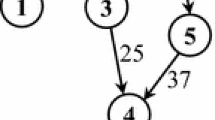Abstract
This paper presents results of a project in which a hardware supported simulation system for Cellular Processing (CP) is implemented. For three dimensional regular CP the hardware archltecture, the cellular description language CDL and a method for the efficient generation of the simulator kernel are explained. For irregular graph based CP the principal characteristics and their hardware support are discussed.
Access this chapter
Tax calculation will be finalised at checkout
Purchases are for personal use only
Preview
Unable to display preview. Download preview PDF.
Similar content being viewed by others
References
Woolson, I. H.: “Some remarkable tests indicating ‘Flow’ of concrete under pressure,”; Engineering News, 54, 18, 1905.
Neville, A. M.: Creep of Concrete: Plain, reinforced and Prestressed, North Holland, Amsterdam, 1970.
Davis, H. E.: “Flow of concrete under sustained compression stresses” Proc. ASCE, Part 3, May 1928.
Davis, R. E. and H. E “Flow of concrete under sustained compression stresses,” Proc. ASTM, 30, Part 2, 1930.
Davis, R. E. and H. E “Flow of concrete under the action of sustained load.” J. Am. Concr. Inst. 37, 1931.
Davis, R. E., Davis, H. E., and Brown, H. E. “Plastic flow and volume changes of concrete.” Proc. ASTM, 37, Part 2, 1937.
Davis, R. E., Davis, H. E., and Hamilton, J. S. “Plastic flow of concrete under sustained stress.” Proc. ASTM, Part 2, 1934.
Glanville, W. H.: “The creep or flow of concrete under load.” Building Research Technical Paper No. 12. H.M. Stationary Office, 1930.
Glanville, W. H. and Thomas, F. G.: “Further investigations on the creep or flow of concrete under load.” In: “Studies in reinforced concrete, Part III,” Department of Scientific and Industrial Research. Building Research Technical Paper No. 12, London, 1930, Technical Paper No. 21. London. 193-9.
Wagner, 0.: “Das Kriechen unbewehrten Betons” (Creep of unreinforced concrete). Deutscher Ausschuss für Stahlbeton, Heft 131, Verlag Wilhelm Ernst and Sohn, Berlin, 1958.
ACI Committee 209, Annotated Bibliography on Shrinkage and Creep in Concrete—1905-1964, American Concrete Institute, Detroit, 1967, 102 pp.
Lorman, W. R.: List of Additional References to Creep and Volume Changes of Concrete 1901-1964, American Concrete Institute, Detroit, 1967, 58 pp.
Hummel, A.: “Vom Kriechen und Fliessen des erhärteten Betons und seiner praktischen Bedeutung” (Creep and flow of hardened concrete and its practical significance), Zement, No. 50 /51, 1935.
Kordina, K.: “Influence of time upon strength and deformation of concrete.” Final report on RILEM Symposium, 1958, RILEM Bulletin No. 9, 1960.
Rüsch, H., Kordina, K., and Hilsdorf, H. K.: “Der Einfluss des mineralogischen Charakters der Zuschläge auf das Kriechen von Beton” (The influence of the mineralogical character of the aggregates upon creep of concrete), Deutscher Ausschuss für Stahlbeton, Heft 146, Verlag Wilhelm Ernst and Sohn, Berlin, 1962.
Alexandrowski, S. W.: “Design of concrete and reinforced concrete structures with regard to temperature and humidity effects taking into account creep” (in Russian), Moscow, 1966.
Illston, J. M.: “The delayed elastic deformation of concrete as a composite material.” International Conference on the Structure of Concrete. Cement and Concrete Association, London, 1968.
Neville, A. M.: “Theories of creep in concrete,” J. Am. Concr. Inst., 52, 1955.
Hansen, T. C.: “Creep of concrete, a Discussion of some fundamental problems,” Bulletin No. 33 of the Swedish Cement and Concrete Institute at the Royal Institute of Technology, Stockholm, 1958.
Ali, J., and Kesler, C. E.:.. “Mechanisms of creep in concrete.” Symposium on Creep of Concrete, ACI Special Paper No.9, Detroit, 1964.
L’Hermite, R.: “What do we know about plastic deformation and creep of concrete?” RILEM Bulletin No. 1, Paris, March 1959.
Heilman, H.: “Beziehung zwischen Zug- und Druckfestigkeit des Betons” (Relations between tensile and compressive strength of concrete), Beton, Heft 2, Beton-Verlag, Dusseldorf, 1969.
Author information
Authors and Affiliations
Rights and permissions
Copyright information
© 1997 Springer-Verlag London Limited
About this paper
Cite this paper
Hartmann, P., Hochberger, C., Hoffmann, R., Schnieder, R., Völkmann, KP. (1997). Hardware Supported Simulation System for Graph Based and 3D Cellular Processing. In: ACRI ’96. Springer, London. https://doi.org/10.1007/978-1-4471-0941-9_17
Download citation
DOI: https://doi.org/10.1007/978-1-4471-0941-9_17
Publisher Name: Springer, London
Print ISBN: 978-3-540-76091-7
Online ISBN: 978-1-4471-0941-9
eBook Packages: Springer Book Archive




